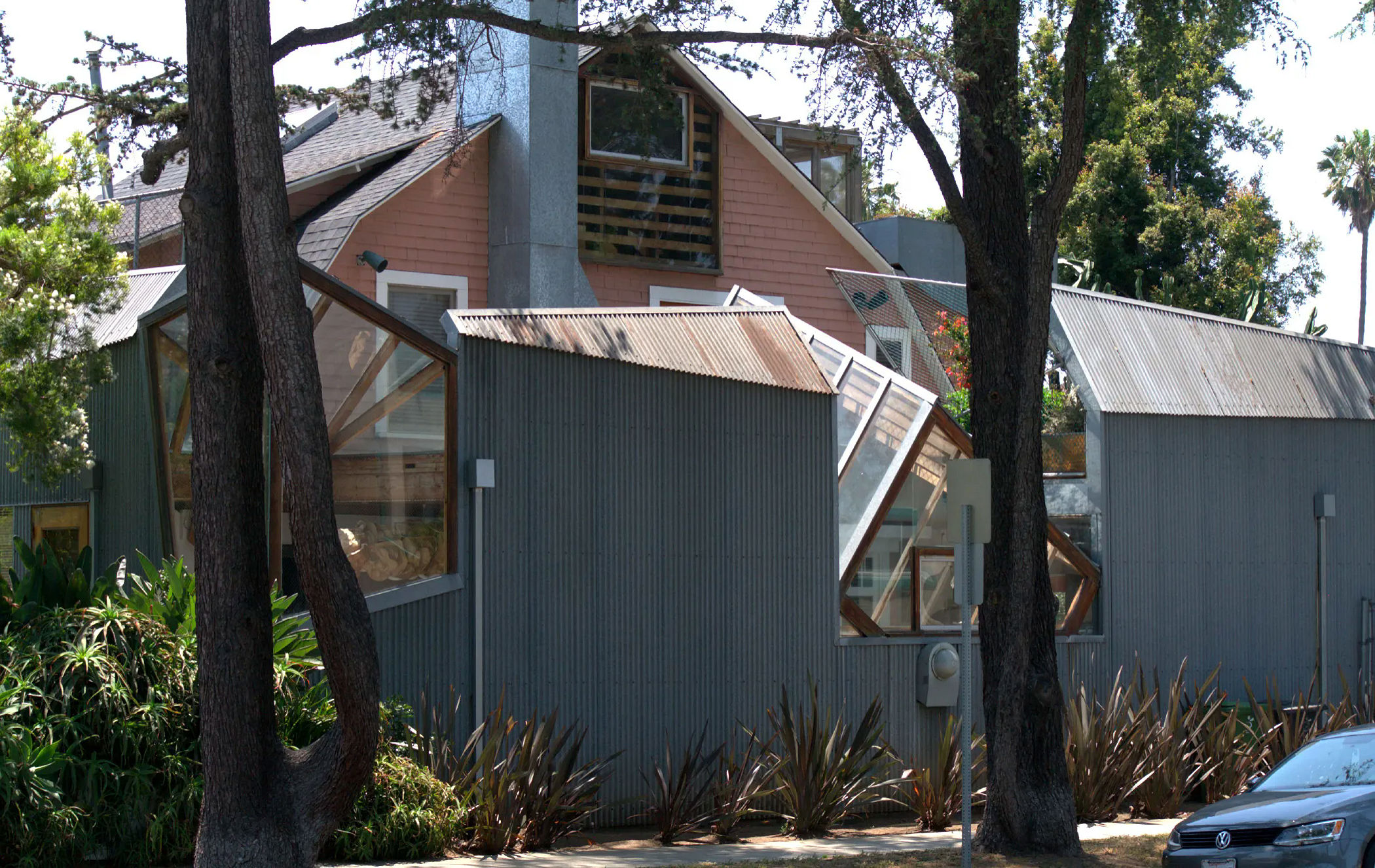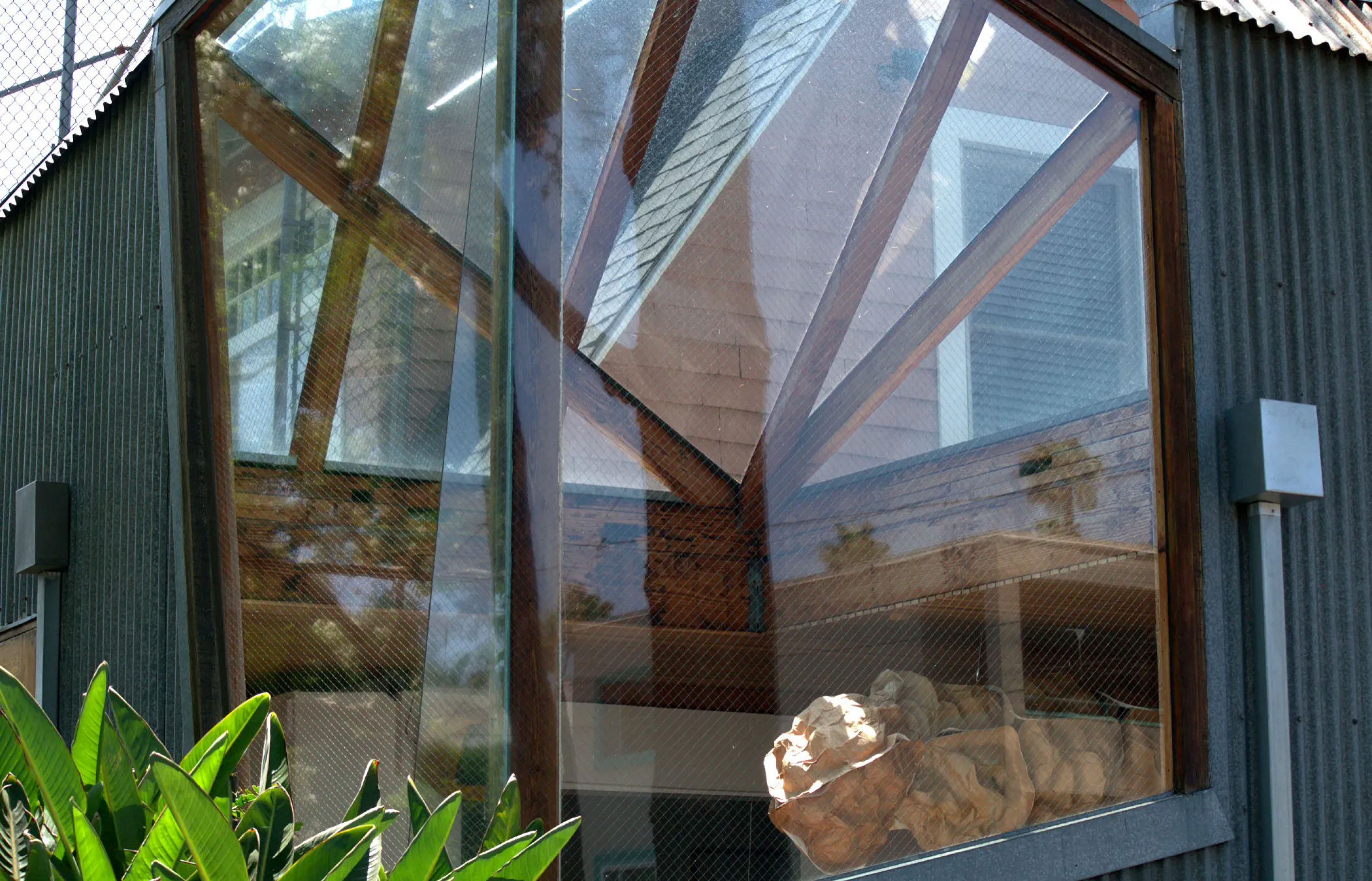Space Oddity
John Thomson
I find it hard to get excited about a house, not the house I grew up in, you understand, which harbors a lifetime of memories both good and bad, but the house with which I have no emotional attachment, the house on the corner, so to speak. And yet, here I was, standing outside a two-storey, 1920 Dutch Colonial, its pink
exterior draped with outcroppings and chain link fencing at the junction of Columbia and 22nd Street in Santa Monica, overcome with admiration and excitement.
Was it the exterior wall cleaved by a vicious slash, the sheer audacity of peppering it with unexpected protrusions or perhaps the cheekiness of the chain link fence risinto the roof, obviously an affront to the neighbors and the neighbors certainly did complain. One resident tried to sue the owner, another tried to have him arrested. Santa Monica is a monied outcropping on the western edge of Los Angeles and cheeky outliers are not welcomed.
I stood there in shock and awe, overcome with admiration for the owner picking away at the Colonial’s classic shape until it became the interior nut of an imaginative sprawl that had extended to the property line. The kitchen, for instance, sat outside the home’s original wall and was now encased in a glass and timber cube. But it all made sense because this wasn’t just a house but the original California home of celebrity architect Frank Gehry which he and his wife Berta bought in 1978 decades before he carved out a name for himself with those impressive calling cards, the Guggenheim Museum in Bilbao, Spain and the Walt Disney Music Hall in Los Angeles.
To Gehry, this old house was more than a living space; it was a laboratory. He used it to test out his fascination with unconventional materials and deconstructed forms. Like a sculptor with clay, Gehry molded the house into weird shapes, adding a bump here and a bump there and over time the Dutch Colonial became a prototype for his early commissions. The Loyola Law School in Los Angeles and the ultra modern Vitra Design Museum in Well am Rhein, Germany are examples of his fascination with flat planes and angularity. Eventually, he moved away from edges in favor of large, curved volumes, such as the Disney Music Hall and the Guggenheim Museum for which he’s remembered, but that came later.
Social psychologist Hazel Marcus talks about the “possible self” and how we aim to become the person we want to be. And the person others see us. We try out various personae during our lifetime and the home, she says, is one area where this can take place. Home becomes an expression of personal choices and aspirations.
Space is both a material entity and a metaphor.
Was Gehry aware he was creating an image of himself as an architectural rebel while he was tinkering with his home? His reputation as an iconoclast has served him well throughout his career.
Not that everybody has been happy with his work. All form and no function is afamiliar complaint.
“He’s the Tim Burton of architecture, a pastiche of himself,” one critic argued, saying his buildings may look good but his contorted designs make it difficult to utilize the interior spaces. Or the roof leaks. Or they need extra buttressing. Or to put it another way, they’re not practical.
Legitimate concerns perhaps but that Dutch colonial, oh, what a building. Bold and honest and unpretentious. Do other people see what I see? The pink exterior and barn-like roofline suggests a quiet 1950’s vibe at odds with the unbridled exuberance of the cut-outs and shape shifting. It’s a host of contradictions and that’s what I love about it. The irregular, asymmetrical shapes speak to me. Constantly under construction - it underwent another major remodelling in 1991 – Gehry’s home reflected its owner’s evolving philosophy on space, scale, and appearance and after awhile the neighbors got used to it.
Frank Gehry doesn’t care. The family moved to another part of Santa Monica ten years ago leaving the house intact but under new ownership. The city even considered turning it into a museum of sorts but Gehry would have none of it.
“I have no intention of having a personal vanity museum while I’m alive or dead,” he declared.
The Dutch Colonial is still standing, a proud and defiant oddity lighting up the Santa Monica streetscape. I was gobsmacked. The street came alive.






